A new type of wave generator has been developed by scientists at the Maritime University Dalian in China. The generator, which is based on the principle of triboelectric power generation, uses flexible strips of conductive material to produce electricity from the motion of waves. Unlike traditional wave generators, which require strong waves to produce electricity, this new design can generate power from even the slightest movement of the water. The generator has the potential to provide energy to underwater sensors and buoys, making it a promising alternative to batteries for coastal instruments and devices.
The concept of wave generators has been around for some time, but traditional designs have been expensive and inefficient. The new triboelectric generator, however, is both compact and affordable, making it a viable option for a range of applications. The generator is made up of multiple layers of conductive material that exchange charges when they come into contact with each other. When the flexible layers are compressed by the motion of the waves, electricity is generated. The generator is designed to mimic the movement of seaweed, with long strips of conductive material that are free to move in the water.
In experiments, the generator was able to produce enough electricity to power 30 LEDs with even the slightest movement of the water. The generator was also able to produce electricity at a depth of 10 meters, making it a promising option for underwater devices. The researchers believe that the generator has the potential to provide a reliable source of energy for coastal instruments and devices, such as buoys and underwater sensors. With further development, the generator could become a viable alternative to batteries for a range of applications.










